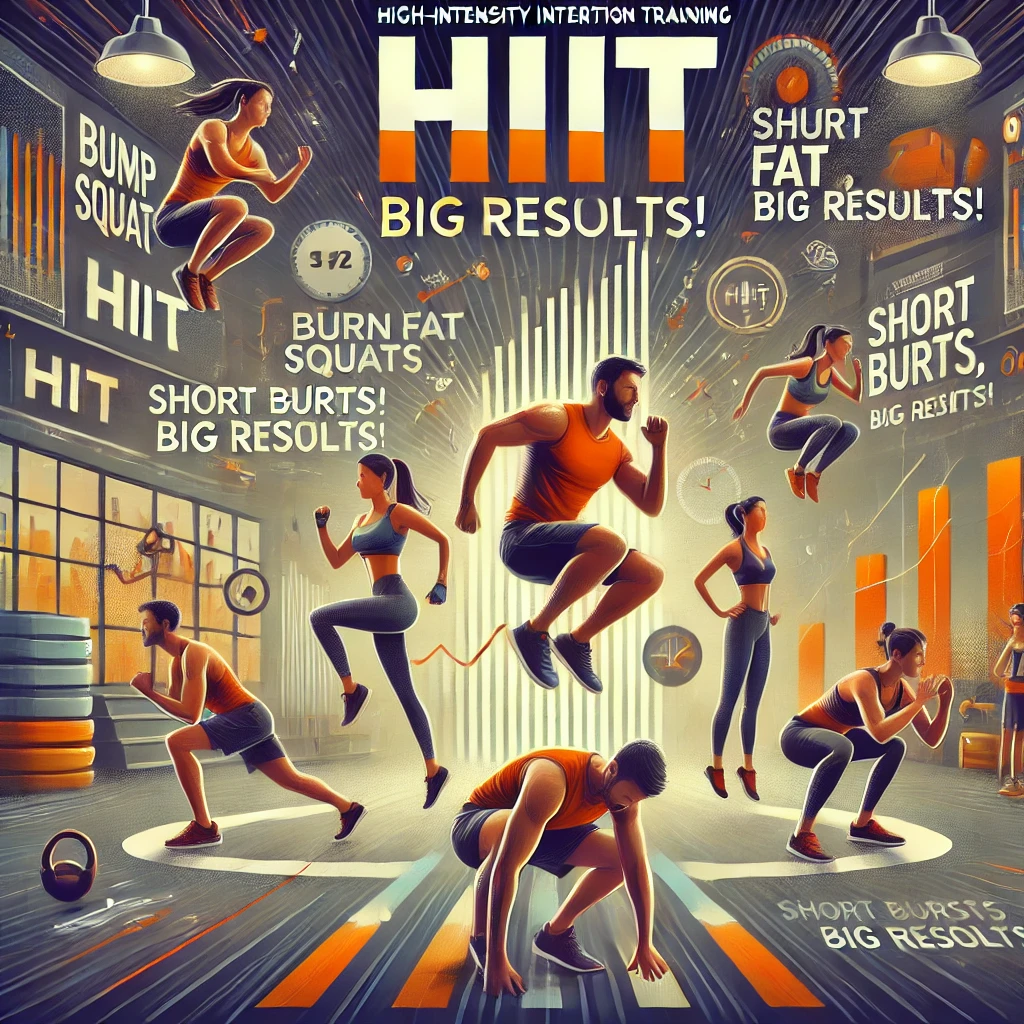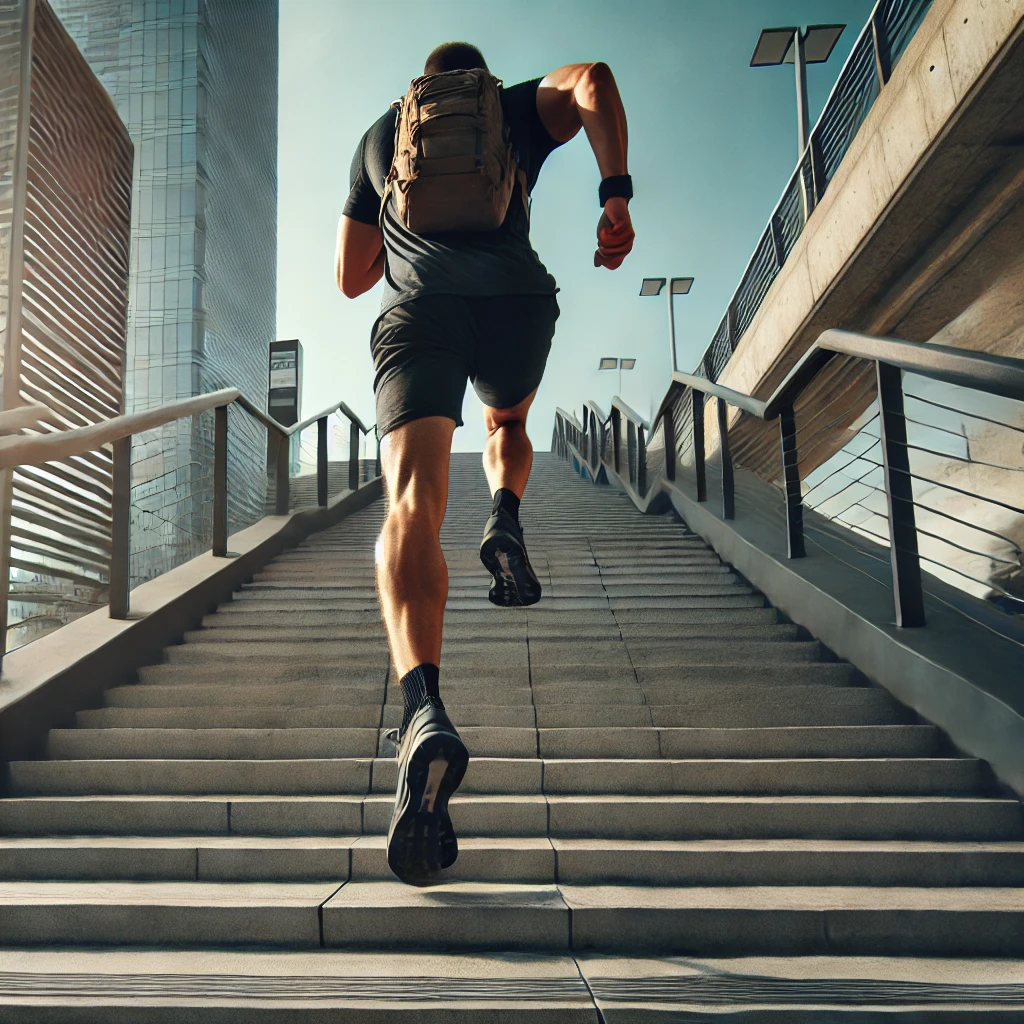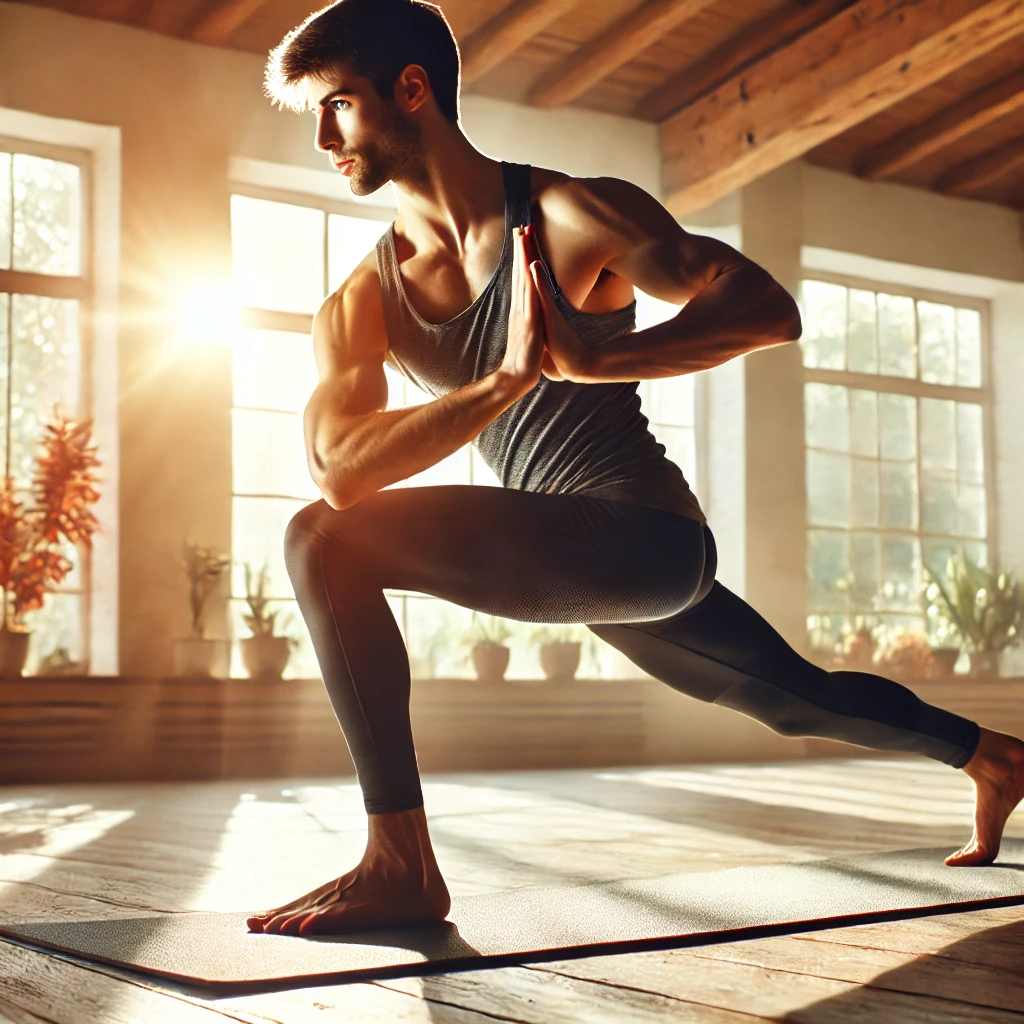
Top 10 exercises: Incorporating effective exercises into a weight loss routine is important because it helps you burn more calories and lose fat faster. Exercises like running, swimming, and strength training make your body stronger and boost your metabolism. This means you burn more calories even when you’re resting!
Fast weight loss happens when you stay consistent and use the right exercise techniques. If you exercise regularly and do it correctly, you will see better results. Staying on track and doing exercises the right way helps you lose weight faster and keeps you healthy.
1:High-Intensity Interval Training (HIIT)

High-Intensity Interval Training (HIIT) is one of the best ways to burn fat quickly. It involves doing short bursts of really intense exercises followed by short breaks or slower exercises. This method makes your heart work hard, helping you burn more calories and fat, even after you finish working out!
HIIT is awesome because you don’t need a lot of time to see great results. It helps speed up your metabolism, which means your body keeps burning calories even when you’re resting.
Exercise Examples:
- Jump Squats: Squat down and then jump up as high as you can!
- Burpees: Start standing, drop to a squat, kick your legs back, do a push-up, return to squat, and jump up!
- Mountain Climbers: Get into a push-up position and quickly bring your knees to your chest, one at a time.
Tips:
If you’re new to HIIT, start with short bursts of intense exercises, like 20-30 seconds, and then take a short break. As you get stronger, you can increase the time and make your workouts harder to keep challenging yourself!
Is HIIT suitable for beginners?
How often should I do HIIT workouts?
2:Running (Cardio)

Description:
Running is a great way to burn calories quickly and improve your heart health. When you run, your heart pumps faster, which helps it become stronger. Running also helps you lose weight because it burns a lot of calories in a short amount of time. Plus, it boosts your mood and makes you feel good!
Exercise Plan:
Here are some fun running variations you can try:
- Sprint Intervals: Run as fast as you can for 30 seconds, then walk or jog slowly for 1 minute. Repeat this several times!
- Long-Distance Runs: Pick a distance you want to run, like 1 mile, and try to complete it at a steady pace. This helps build your stamina.
- Treadmill Workouts: If you’re indoors, set the treadmill to a comfortable speed and run for 20-30 minutes. You can also try increasing the incline to make it more challenging.
Tips:
To get the most out of your runs, focus on your running form. Keep your head up, shoulders relaxed, and arms at your sides. Your feet should land softly, and try not to overstride. Also, remember to breathe deeply! Inhale through your nose and exhale through your mouth to help keep your energy up and maximize fat burn.
How long should I run to lose weight?
Should I run every day?
3: Jump Rope

Description:
Jumping rope is a fun and effective way to get a full-body workout! It burns calories quickly because it uses many muscles at the same time, including your legs, arms, and core. When you jump rope, your heart rate goes up, which helps improve your cardiovascular health. It’s a great exercise for anyone, whether you’re a beginner or an expert, and it can be done almost anywhere!
Exercise Plan:
Here’s a simple jump rope plan you can follow, starting from beginner to advanced levels:
- Beginner:
- Jump for 30 seconds, then rest for 30 seconds.
- Repeat this for a total of 5 sets.
- Focus on keeping a steady rhythm as you jump.
- Intermediate:
- Jump for 1 minute, then rest for 30 seconds.
- Repeat this for a total of 8 sets.
- Try mixing in different jumps, like two feet together or one foot at a time.
- Advanced:
- Jump for 2 minutes, then rest for 30 seconds.
- Repeat this for a total of 10 sets.
- Challenge yourself by doing tricks like crossing the rope or double unders (where the rope goes under your feet twice in one jump)!
Tips:
Jumping rope not only helps you burn calories but also improves your coordination and endurance. Coordination is important because it helps your body move smoothly and work well together. The more you practice jumping rope, the better you’ll get at it!
To improve your endurance, try to jump for longer periods without taking a break. This means your heart and muscles will get stronger over time. Make sure you also wear proper shoes with good support to protect your feet while jumping.
Remember to keep your elbows close to your body and use your wrists to turn the rope. This technique will help you jump higher and faster, making your workout more effective. So grab your jump rope, have fun, and enjoy the benefits of this amazing exercise!
How long should I jump rope to lose weight?
Is jump rope a good way to improve coordination?
4: Strength Training

Description:
Strength training is an important part of any weight loss plan because it helps build muscle mass. When you have more muscle, your body burns more calories, even when you’re not exercising! This is because muscle tissue requires more energy to maintain than fat tissue. So, the more muscle you have, the faster your metabolism works. This means that building muscle can help you lose weight more effectively and keep it off.
Exercise Examples:
Here are some great strength training exercises you can try:
- Push-ups:
Push-ups are a great way to build strength in your arms, chest, and core. Start by lying face down on the floor with your hands placed slightly wider than your shoulders. Push your body up until your arms are straight, and then lower yourself back down. You can start with your knees on the ground if you find it too hard at first. - Deadlifts:
Deadlifts are excellent for building muscle in your legs, back, and core. To do a deadlift, stand with your feet shoulder-width apart and a weight (like a dumbbell or kettlebell) in front of you. Bend your knees and lower your body to grab the weight, keeping your back straight. Stand up tall, lifting the weight with you, and then lower it back down to the ground. - Kettlebell Swings:
Kettlebell swings work many muscles at once and are a fun way to get your heart rate up. Stand with your feet shoulder-width apart and hold a kettlebell with both hands in front of you. Bend your knees slightly and swing the kettlebell between your legs. Then, use your hips to swing it up to shoulder height. Make sure to keep your back straight and your core tight!
Tips:
One of the coolest things about strength training is that muscle burns more calories than fat, even when you’re resting. This means that if you have more muscle, your body will burn more calories throughout the day, making it easier to lose weight and maintain a healthy body.
To get the most out of your strength training, try to include a variety of exercises that target different muscle groups. This will help you build a balanced and strong body. Start with lighter weights to learn the proper form, and as you get stronger, gradually increase the weight.
Also, give your muscles time to rest and recover. It’s important to allow a day or two between strength training sessions for each muscle group to prevent injury and allow growth. With regular strength training and a good diet, you’ll see amazing results and feel stronger and healthier!
How often should I lift weights?
Should I lift heavy weights or lighter weights with more repetitions?
5: Swimming

Description:
Swimming is an amazing exercise because it provides a full-body workout while being low-impact, which means it’s easy on your joints. When you swim, you use almost all the muscles in your body, including your arms, legs, back, and core. This makes swimming a great way to burn calories and tone muscles without putting too much stress on your body. Plus, being in the water can feel refreshing and fun, making it easier to stick to your exercise routine!
Exercise Plan:
Here’s a simple swimming plan you can follow for weight loss:
- Warm-Up: Start by swimming slowly for about 5-10 minutes. This helps get your muscles ready and prevents injuries. You can do a gentle stroke, like freestyle or backstroke.
- Laps: Aim to swim several laps at a steady pace. For beginners, try swimming 4-6 laps (back and forth across the pool) without stopping. As you get more comfortable, you can increase the number of laps.
- Interval Training: To boost your weight loss, you can mix in some interval training. Swim one lap as fast as you can, then swim the next lap at a slower pace. Repeat this for 20-30 minutes. This will help you build endurance and burn more calories.
- Techniques: Work on your swimming techniques to make your strokes more efficient. Practice the freestyle stroke, breaststroke, and backstroke to work different muscles. You can also take swimming lessons to improve your skills and learn new strokes.
Tips:
One great thing about swimming is that water provides natural resistance. This means that when you move through the water, it pushes against your body, helping to tone your muscles. You can use this resistance to your advantage by trying different exercises in the water, like water jogging or using water weights.
Additionally, swimming is an excellent way to improve your cardiovascular fitness, which helps your heart and lungs get stronger. Always remember to stay hydrated, even when you’re swimming, as you can still lose water while exercising in the pool.
Whether you’re a beginner or an expert swimmer, making swimming a regular part of your exercise routine can lead to great results. Enjoy the fun of moving in the water while building strength and losing weight!
How many calories can I burn by swimming?
Is swimming a good way to lose weight?
6: Cycling

Description:
Cycling is a fun and effective way to burn calories. Whether you are riding a bike outdoors, using a stationary bike indoors, or attending a spin class, cycling can help you get in shape while having a great time. One of the best things about cycling is that it works for people of all fitness levels. You can start slow and build up speed or distance as you get stronger. Plus, cycling is easy on your joints, making it a perfect exercise for anyone who wants to stay active without putting too much pressure on their knees or ankles.
When you cycle, your muscles work hard, especially the ones in your legs and core. As you pedal, your heart rate goes up, and you start to burn calories. The faster or harder you go, the more calories you burn. Cycling also makes your heart stronger, improves your lung health, and helps you lose fat.
Exercise Plan:
Cycling comes in different styles, so you can pick the one that works best for you:
- Stationary Cycling: This is done indoors on a stationary bike. You can adjust the speed and resistance to make the workout easier or harder. It’s a great way to cycle even when the weather is bad outside.
- Outdoor Biking: Riding a bike outside can be fun and adventurous. You get fresh air and a change of scenery. You can ride on the road, trails, or in parks. It’s also a good way to explore new places while staying fit.
- Spin Classes: Spin classes are usually done in a group setting with an instructor. The instructor guides you through different cycling speeds and resistance levels, often to upbeat music. This can make the workout feel like a party while still giving you a great workout.
Tips for Maximum Fat Burn:
To burn the most fat while cycling, try these tips:
- Hill Cycling: Riding your bike uphill is harder than cycling on flat ground. It forces your muscles to work harder, which burns more calories. You can find a hilly route outside or increase the resistance on your stationary bike to simulate a hill.
- Interval Training: Interval training means switching between fast and slow speeds. For example, you can cycle as fast as you can for 30 seconds, then slow down and pedal at an easy pace for 1 minute. Repeat this for 20-30 minutes. This type of training keeps your heart rate high and burns more fat.
Cycling is not only great for fitness but also a fun way to stay active. With the right plan and a little motivation, you can enjoy cycling and reach your fitness goals!
How long should I cycle to lose weight?
Is cycling a good way to build muscle?
7: Rowing

Description:
Rowing is an excellent exercise that works your entire body, making it both fun and effective. When you row, you use the muscles in your upper body (like your arms, shoulders, and back) and your lower body (like your legs and core). This means rowing gives you a full-body workout. It’s great for building strength and endurance, as well as burning calories.
When you pull the handle of the rowing machine or oars, your arms and back muscles get stronger. At the same time, your legs push against the footrests, which works your legs and glutes (the muscles in your butt). Rowing also helps improve your heart health by raising your heart rate and getting your blood pumping. The more you row, the stronger your heart and lungs become, and the more calories you burn.
Exercise Plan:
There are two main ways to row, and you can choose the one that fits your lifestyle:
- Indoor Rowing Machines: These machines can be found in gyms or you can buy one for your home. They let you simulate the movement of rowing without being on the water. You can adjust the resistance to make it easier or harder, and you can row at your own pace. It’s a great workout option, no matter the weather outside.
- Outdoor Rowing: If you live near a body of water, outdoor rowing can be an exciting way to exercise. You can row in a boat, either alone or as part of a team. Outdoor rowing not only gives you a great workout but also lets you enjoy the fresh air and beautiful surroundings.
Tips for Maximum Efficiency and Injury Prevention:
To make sure you get the best workout while staying safe, here are some important tips for your form and posture:
- Keep Your Back Straight: When rowing, always keep your back straight, not slouched or hunched. A straight back helps prevent injury and ensures that you’re using your muscles properly.
- Use Your Legs, Not Just Your Arms: Many people make the mistake of only using their arms to row. Rowing is a full-body exercise, so push off with your legs to get the power you need. Your legs are stronger than your arms and should do most of the work when rowing.
- Relax Your Shoulders: Try to keep your shoulders relaxed and down. If your shoulders are tensed up toward your ears, you might hurt yourself. Relaxing your shoulders will make your rowing more efficient.
- Focus on Smooth Movements: Rowing should feel smooth and controlled. Avoid jerky or fast movements. Pull the handle toward your chest in a controlled motion and then return it slowly as you move your body forward.
By following these tips and practicing good form, rowing can be a great way to strengthen your body and improve your fitness without getting injured. Rowing not only works your upper and lower body, but it’s also a great way to stay fit and have fun!
Is rowing a full-body workout?
How often should I row to see results?
8: Stair Climbing

Description:
Stair climbing is a fantastic way to work your legs and core muscles while also giving you a great cardio workout. When you climb stairs, your leg muscles—like your thighs, calves, and glutes (the muscles in your butt)—have to work hard to push your body up. At the same time, your core muscles, which include your stomach and lower back, help keep you balanced and steady as you climb. Stair climbing is great for building strength in your lower body, and it also raises your heart rate, which improves your heart health and burns calories.
The higher you climb, the harder your muscles work, which makes it a simple but effective way to get stronger and fitter. Plus, stair climbing can be done almost anywhere, whether it’s on real stairs or a stair machine at the gym.
Exercise Plan:
There are a couple of ways to include stair climbing in your workout routine:
- Real Stair Climbing: If you have access to a set of stairs—whether it’s at your house, in a park, or even at a stadium—you can start climbing! Simply walk or run up the stairs and walk back down to recover. You can climb as many flights of stairs as you like, depending on your fitness level.
- Stair Machines: If you’re indoors or at a gym, a stair machine (also called a stair stepper) is a good alternative to real stairs. The machine lets you adjust the speed and intensity, making it as easy or challenging as you want. This can be a great option if you don’t have access to real stairs.
Tips for Added Intensity and Better Results:
To get the most out of your stair climbing workout and make it more challenging, try these tips:
- Stair Sprints: Once you’re comfortable with regular stair climbing, try sprinting up the stairs as fast as you can. This increases the intensity of your workout and makes your heart work harder, helping you burn more calories. After each sprint, walk back down and rest before sprinting again.
- Weighted Stair Climbs: Another way to increase the intensity is by carrying extra weight. You can use a backpack filled with books or weights, or hold dumbbells in your hands while climbing. This makes your muscles work even harder, which helps you build strength faster.
- Use the Whole Foot: When climbing stairs, make sure to step with your entire foot on each step instead of just your toes. This helps spread the pressure evenly and prevents injury to your knees or ankles.
- Engage Your Core: Keep your stomach muscles tight while climbing stairs to help support your lower back and improve your balance. This also helps work your core muscles more effectively.
Stair climbing is a simple but powerful exercise that can help you get fit. It strengthens your legs, improves your balance, and gives you a great cardio workout all at once. With stair sprints or added weights, you can challenge yourself even more and reach your fitness goals faster!
How many calories can I burn by climbing stairs?
Is stair climbing good for your knees?
9: Yoga for Weight Loss

Description:
Yoga is a wonderful exercise that helps improve flexibility, reduce stress, and even support weight loss. While some people think yoga is only about stretching and relaxing, certain types of yoga can also help you burn calories and build muscle. By practicing yoga, you can improve your balance, strengthen your muscles, and feel calmer, which can all help you manage your weight better.
Yoga is also great for reducing stress, which is important because high stress can lead to weight gain. When you’re stressed, your body produces a hormone called cortisol, which can make you feel hungry even when you don’t need food. Yoga helps you relax, lowering your stress levels and helping you stay focused on your health goals. Plus, as your flexibility improves, you’ll find other exercises easier to do, making yoga a great addition to any fitness plan.
Exercise Examples:
There are many types of yoga that can help with weight loss, and here are a few examples:
- Power Yoga: Power yoga is a faster-paced, more intense form of yoga that helps burn calories and build strength. In power yoga classes, you move quickly from one pose to the next, which keeps your heart rate up and helps tone your muscles. It’s a great option if you want a workout that challenges your body.
- Hot Yoga: In hot yoga, you practice in a room that is heated to around 90-100°F (32-38°C). The heat helps you sweat more, which can make you feel like you’re working even harder. This type of yoga can improve your flexibility and help burn calories as your body works to stay cool.
- Vinyasa Flows: Vinyasa yoga involves flowing from one pose to the next in a smooth and continuous way. This type of yoga can be both calming and challenging, depending on the pace. Vinyasa flows focus on both strength and flexibility, making it a great way to work your muscles while also relaxing your mind.
Tips for Strength Building and Balance:
Certain yoga poses are especially helpful for building strength and improving balance. Here are some tips and poses to focus on:
- Plank Pose: The plank pose is great for building strength in your arms, shoulders, and core (the muscles in your stomach and back). To do this pose, you hold your body in a straight line, balancing on your hands and toes, as if you were at the top of a push-up. Try to hold the pose for 20-30 seconds, then rest.
- Warrior Poses: Warrior poses (like Warrior I, II, and III) are fantastic for strengthening your legs, hips, and core while improving your balance. In these poses, you stretch your legs wide apart, bend one knee, and stretch your arms out. These poses help you build both strength and flexibility.
- Tree Pose: The tree pose is all about balance and focus. In this pose, you stand on one leg while placing the other foot on your thigh or calf. It helps strengthen your legs and improve your balance. Focus on a spot in front of you to help you stay steady.
- Chair Pose: In chair pose, you bend your knees and lower your body as if you are sitting in an invisible chair. This pose works your thighs, glutes, and core muscles. It’s a great way to build strength in your lower body.
By including these poses in your yoga routine, you can build muscle, improve your balance, and burn calories, all while enjoying the calming and relaxing effects of yoga. Yoga is a great way to stay fit, reduce stress, and help you reach your weight-loss goals!
Is yoga effective for weight loss?
What type of yoga is best for weight loss?
10: Walking

Description:
Walking may seem like a simple activity, but it can be a very effective way to stay fit, especially when done regularly. Even though it’s a low-impact exercise, meaning it’s gentle on your joints, walking can still help you burn calories, improve your heart health, and strengthen your muscles. Walking doesn’t require any special equipment, and it can be done almost anywhere—around your neighborhood, at a park, or even indoors.
Walking is a great choice for people of all fitness levels. Whether you’re just starting your fitness journey or already active, walking helps you stay healthy by getting your heart rate up without putting too much strain on your body. Plus, walking outdoors gives you the chance to enjoy fresh air and nature, which can make exercising more enjoyable.
Exercise Plan:
To make the most of walking, it helps to have a plan. Here’s how you can set daily walking targets and add variety to your walks:
- Daily Walking Targets:
A good goal is to aim for at least 30 minutes of walking every day. If you’re just starting out, you can begin with shorter walks and slowly work your way up. You can also count your steps—many people aim for 10,000 steps a day, which is about 5 miles. You can use a step counter or smartphone app to track your steps and progress. - Brisk Walking:
Brisk walking is when you walk faster than your usual pace, but not so fast that you’re running. It’s a great way to increase the intensity of your walk. Your heart will pump faster, and you’ll burn more calories. To check if you’re walking briskly, try talking. You should be able to talk, but you’ll be a little out of breath. - Hiking:
If you enjoy being outdoors and want more of a challenge, hiking is a fun way to take your walking workout to the next level. Hiking usually involves walking on trails that go up and down hills, which works your muscles harder than walking on flat ground. It also lets you explore new places and enjoy nature while exercising.
Tips for Making Walking a Daily Habit:
Here are some tips to help you make walking a regular part of your routine:
- Schedule Your Walks:
Try to walk at the same time each day. Whether it’s in the morning before school, during a lunch break, or in the evening, having a set time helps make it a habit. Walking after meals can also aid digestion and help you feel more energized. - Mix It Up:
Don’t let walking get boring! Change up your walking routes or listen to music, a podcast, or an audiobook while you walk. You can even walk with a friend or family member to make it more social. - Combine Walking with Other Exercises:
Walking is great on its own, but you can also combine it with other exercises to boost your fitness. For example, you could walk to the gym, do a workout, and then walk back. You can also add short bursts of jogging, lunges, or stretching during your walk to make it more challenging. - Set Small Goals:
Start with smaller goals, like walking for 10-15 minutes a day, and then gradually increase the time or distance. Reaching these goals will make you feel accomplished and motivate you to keep going.
Walking is an easy and enjoyable way to stay active. By making it a daily habit and adding variations like brisk walking or hiking, you can improve your fitness, burn calories, and feel better both physically and mentally. Whether you walk alone or with others, walking is a simple but powerful tool to help you stay healthy!
Conclusion
Incorporating a variety of exercises into your weight loss routine is essential for achieving sustainable results. By combining cardio activities like running, swimming, and cycling with strength training exercises like HIIT, weightlifting, and yoga, you can target different muscle groups, burn calories efficiently, and boost your metabolism.
Key takeaways from this guide:
- Cardio exercises like running, swimming, and cycling help increase your heart rate, improve cardiovascular health, and burn calories.
- Strength training exercises such as HIIT, weightlifting, and yoga build muscle mass, which helps boost your metabolism and burn more calories even at rest.
- Flexibility and balance exercises like yoga and Pilates improve your overall body coordination and reduce the risk of injuries.
- Consistency is key: Regular exercise, combined with a healthy diet, is crucial for achieving and maintaining weight loss.
- Find activities you enjoy: Choosing exercises that you enjoy will make it easier to stick to your routine and stay motivated.
Remember, it’s important to listen to your body and consult with a healthcare professional before starting any new exercise program. By incorporating 1 these exercises and tips into your lifestyle, you can effectively support your weight loss goals and improve your overall health and well-being.
How many steps should I take per day to lose weight?
Is walking a good way to lose belly fat?
read the full article on effective weight loss
The Volcanic Secret for Healthy Weight Loss with LavaSlim
Are you looking for a natural solution for effective and sustainable weight loss? Discover LavaSlim, a revolutionary supplement that targets the real cause of your unexplained weight gain: a low internal body temperature, according to recent scientific studies. Made with 6 powerful ingredients sourced from volcanic regions, LavaSlim helps ignite your metabolism and turn your body into a calorie-burning machine!
- Targets low internal body temperature, the key reason for slow metabolism.
- Contains 6 clinically proven natural ingredients.
- Boosts your metabolism, helping you lose weight faster and more efficiently.
- Manufactured in the USA to ensure the highest quality.
Special Offer: Order LavaSlim now and choose from 3, 6, or 12-month supplies. When you order 3 or more bottles, you’ll get FREE shipping and access to 2 bonus eBooks, including “Burn Fat While You Sleep” and “The Real Me”, both packed with tips to enhance your weight loss journey.
Plus, with LavaSlim’s 180-day money-back guarantee, there’s no risk! Try it for yourself, and if you don’t see dramatic results, you’ll get a full refund.
Start Your Weight Loss Journey Today! Click below to claim your special offer and transform your body with Lava Slim.
Why wait? Get LavaSlim today and unleash the volcanic power within you!

Leave a Reply